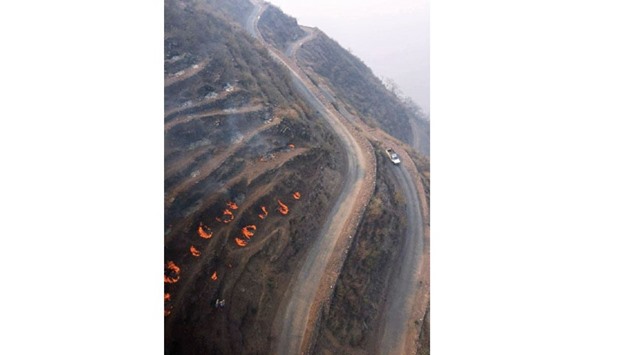Thousands of labourers backed by water-carrying helicopters were battling to control fires that have killed two people in the northern Himalayan state of Uttarakhand, officials said yesterday.
Fires have swept through more than 1,900 hectares of forest but have so far not threatened towns in Uttarakhand which draws tens of thousands of tourists every year, officials and media reports said.
Environment and Forests Minister Prakash Javadekar said some 6,000 labourers were being deployed to help fight the fires. They started about one month ago but according to other officials have intensified in recent days.
Javadekar told reporters the fires have broken out at 1,200 locations in the densely forested state, known for its remote valleys, over the last month.
“This can be compared with the worst fire of 2012 when fire took place in 1,300 places and (covered) more than 2,000 hectares,” the minister said.
Senior Uttarakhand disaster management official Piyoosh Rautela said two people have been killed in recent days, although local media reported six deaths since the state’s fire season started at the beginning of February.
He said disaster relief experts were being deployed to help those already on the ground.
“They are all working with two Indian Air Force choppers which are spraying water over isolated forest areas in the state,” Rautela, executive director of Uttarakhand’s disaster management and mitigation centre, said.
“The forests are spread across our six districts but are all isolated and we are getting them under control,” he added.
Pauri, Nainital, Rudraprayag and Tehri are among the worst hit districts, officials said.
They said it was unclear what started the fires but some have linked the intensity of the blazes to the drought gripping India.
India is suffering its worst water crisis in years, with the government saying that about 330mn people, or a quarter of the population, are suffering from drought after the last two monsoons failed.
Javadekar said the government would investigate if timber mafia was behind the blaze. “But our first priority is to douse the fire and give relief to people.”
The Prime Minister’s Office has earmarked Rs50mn for the fire-fighting operation. The home ministry is monitoring the situation, Javadekar said.
With the weather offices predicting a significant fall in day temperatures after today, the fires may get under control soon, the officials said but added that the administration will have to remain alert for the next 35 days to prevent fresh forest fires. .
“It’s known in these parts that forest fires follow a general five-year cycle, and the intensity this year can be seen in this light. The drought and low humidity over two years have played a big role,” according to Ashwani Kumar, Director-General of Indian Council of Forestry Research and Education.
The Forest Survey of India warns state governments about the probability of forest fires and preparations are usually taken up in February to contain them.
Apart from the threat to life, forest fires are ecologically damaging depending on whether they are ground fires or crown fires.
When fires spread at the level of treetops - the crown - they irreversibly damage trees. The fires in Uttarakhand this year, according to Kumar are largely ground fires.
Using helicopters to pour water and put out the fires is not a feasible option in the affected area because there are not enough lakes or large water sources nearby. The best way is to recruit more manpower to do the job, he added.
Compared to the US and Australia, forest fires in India occur largely due to human actions.
Forest dwellers often start fires to create new ground to get a fresh crop of grass for livestock. Kumar said such activities went out of control on many occasions and there should be greater awareness.
Uttarakhand, with its Himalayan mountains, rivers, treks and Hindu religious sites, is a popular destination for local tourists who flock there to escape India’s harsh summer.

Fires rage in a forest near Rudraprayag in Uttarakhand yesterday.

